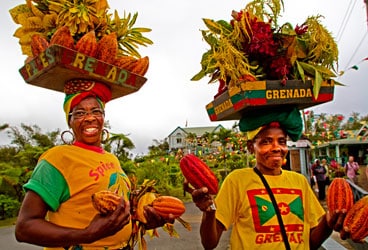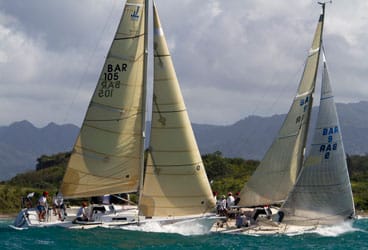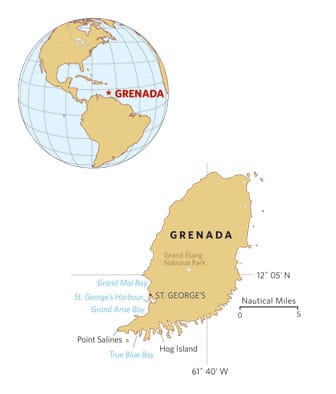
Grenada
I have one foot in the primitive age and one foot in the modern age,” announced Telfor Bedeau. As brown and sinewy as the branch at which he was hacking, Telfor swiftly fashioned a walking stick, then slid his machete back into a sheath slung across his chest. The swashbuckling machete stood in sharp contrast to the bright plastic “jelly” shoes and cornflower-blue raincoat that completed his outfit.
Telfor was our energetic guide on a trek through Grenada’s Grand Étang National Park. He’s 72 years old and lives in a hand-hewn home with no electricity—but he uses a cellphone. Well-versed on politics and current events, he reads ardently—by candlelight.
His self-observation reflected the great dichotomy of Grenada itself: its refreshing span of old and new. Wiped out by a hurricane eight years ago, Grenada was restored with modern insight and infrastructure. Grenada is one of the most diverse, clean, friendly, and gorgeous places to which I’ve sailed—and I haven’t even mentioned the food yet.
My friends and I timed our sojourn to the Spice Isle, as Grenada is sometimes known, to coincide with several sailing events, but first there was some rest and relaxation on which to catch up. A relative newcomer to the bucket-list of destinations serviced by The Moorings, the Grenada base promised countless islands, sandy beaches, historic sites, rum distilleries, spice plantations, waterfalls, and national parks. Given that description, I hesitated before our plan—R&R might have to give way to A&A: action and adventure.
It was dark when we landed at Maurice Bishop International Airport and taxied to The Moorings base at Camper & Nicholsons’ Port Louis Marina. Arriving at night, I appreciated the broad, even, lit docks at the marina, which was a manicured, secure setting with restaurants, shops, a pool, and soup-to-nuts yacht services.
The gentle slap of halyards and groaning of dock lines were interrupted much too early the next morning by the hubbub of sailors arriving at the marina for a regatta. As racers noisily jostled with sails, duffel bags, and cases of water and beer, we readied for our own trip.
Historic St. George’s Harbour has two forks, the lagoon that lies to the south, where we were, and the Carenage, which lies to the north. Named for the practice of careening—beaching ships for maintenance—this sheltered thumb of water is edged, like a Monopoly board, with bright boxy houses, municipal buildings, and churches. We steered our catamaran to follow the procession of raceboats through this storybook setting.

“Awful light breeze for a regatta,” I thought, but as we peeked out of the bay the wind hit us square on the beam. Our beefy Moorings 4600 shook it off and took it in stride. We reached out to watch the race starts on Grand Anse Bay, then angled around Point Salines. After rounding the point, we bounded into huge swells and a breeze generated by the pesky squalls that tumbleweed across the Atlantic. It was a delightful frolic, but once we’d had our fill, we ducked into True Blue Bay.
Grenada is called the Spice Isle because of the many spices grown here, but I like to think it’s also because the island is shaped like a big jalapeño. Grenada is 21 miles long and a fat 12 miles at the middle, and its southern coast squeezes to a tip pointing west. Along this bottom curve are several excellent hurricane holes that feature narrow, south-facing entrances, hilly perimeters, and plenty of mangroves on which to lash. And because the island lies at 12 degrees north, it’s technically off course for all but the most deviant hurricanes.
But that was the least of our worries on our midwinter sojourn.
We enjoyed the peaceful solitude of Port Egmont, the nightly specials and dancing at True Blue Bay’s Dodgy Dock, and a get-together at Roger’s Barefoot Bar, on Hog Island. Our days were a shameful succession of sampling anchorages, cuisine, and local beers, with Carib lager beating Stag two to one in our group.
Rested up, we decided to tackle the island’s interior.
We tied up at True Blue Bay Resort and Marina and embarked on our own adventures. Grenada offers many diversions: You can swim, snorkel, dive, jet boat, hike, bike, fish, and kayak. You can play golf, cricket, or tennis. You can even go tubing on a river. I can’t image a better destination for a family with kids—or for the young-at-heart.
Inexpensive buses can take you almost anywhere on the island, but we took advantage of the knowledge and charm of one of Grenada’s excellent tour guides, Roger Augustine. He’s famous for appearing in the tourism ads, and it seems that all 100,000 residents know him. Wherever we went, lovely ladies chorused, “Hello, Roger!”
From St. George’s, which is Grenada’s capital and largest city, we climbed through the belly of the island up nearly 2,000 feet, where the winding road is carved out of ruddy soil and the high banks sprout enormous tufts of cabbage fern. The air cooled, the sky turned to gray, and we found ourselves in a lush, green rain forest that reminded me of the movie Jurassic Park.
Named for the large lake at its center, Grand Étang National Park encompasses 3,000 acres of rain forest, and it was here that we enjoyed a morning hike under the guidance of Telfor Bedeau. Along the way, he pointed out unusual plants and their medicinal uses, occasionally peeling off a curl of fragrant bark or crumbling an aromatic leaf in the palm of my hand. Although elsewhere on the island it was the dry season, which runs from January to May, a perpetual heavenly mist presides at altitude. We paused as a pair of monkeys swung through trees thick with moss. Finally, we reached the lake itself, which has formed in a volcanic crater.
According to local superstitions, this marshy lake is bottomless and possessed by a spirit. “The believers think deities live in the lakes, and this one here has a lady,” explained Telfor. “They come, beat drums, have rituals, and cook the best food and bring it alongside the lake.” But no one swims, for fear of angering the fickle spirit Mamadjo.
But the rascal Telfor couldn’t leave things alone, and he plotted to measure the depth of the lake. “They said I was going to interfere with their goddess and predicted all sorts of bad things would happen, and I would get swallowed up in the bottomless hole. I said, ‘OK, that would be a good way to go. No problem!’”
With a lead line he measured the depth of the entire lake. “Eighteen feet!” he said, laughing. “They didn’t like that.” He shook his head. “I graduated from believing in these things for a long time before, but I read a lot, and I realize these things are just mythology. But some people believe in it.”
We picnicked at the edge of Grand Étang, disturbed by neither spirits nor marauding monkeys, then headed back down the hill. Cradled and secure in our spacious catamaran that night, we slept well, cooled by a gusty breeze that set the rig vibrating.
Interest in eating locally grown food is nothing new in Grenada. Fertile volcanic soil and a perfect climate have combined for centuries to produce all types of fruits, vegetables, and spices. So the next day, our tours took a culinary turn, and we looped around the 133-square-mile island visiting the historic Dougaldston Spice Boucan and Belmont Estate, the Gouyave Nutmeg Processing Station, the Grenada Chocolate Factory, and the River Antoine rum distillery, sampling delicious organic chocolates and fiery rums along the way.
Island nightlife was casual, with a convivial atmosphere in which locals and visitors mix it up. At the jammed bar that evening, I accepted a dance with a gargantuan man with Don King hair. Once on the dance floor, with a chance to survey my partner, I realized he was a cab driver outfitted to advertise his trade. He wore a taxi-yellow polo shirt stretched over his big barrel chest, baggy, knee-length yellow shorts, yellow high-tops, and yellow socks with red stripes. As we merrily danced to the beat, I had to make a concession to myself: “Yes, I’m dancing with Ronald McDonald. Well, this is a first!”
The next morning, my humility still in check, we pointed our catamaran back toward St. George’s. Under full sail, with the wind and seas at our stern, it was a glorious romp that ended too soon.
But we were eager to watch the annual workboat regatta at Grand Anse Beach. Entrants from fishing villages throughout Grenada, Carriacou, and Petite Martinique compete in stout wooden sailboats painted vivid colors, and the races start right at the surf line. The weekend was a lively carnival of food, drink, music, and people-watching—on top of the thrills and spills of the races.
Afterward, a long stroll down the strand took us to the Coconut Beach Restaurant where owners Auntie Pat and Scratch greeted us. There were but three choices for lunch—fish, chicken, or lambi—with sides of sweet potato, rice, or a mysterious vegetable called christophine. Curious, I ordered the unfamiliar curried lambi and christophine, and I was presented with a mountain of melt-in-your-mouth strips of spiced conch and what I know as chayote.
There were clusters of picnic tables at the water’s edge, but we tucked inside beneath a lazy ceiling fan. By this point in the trip, my inner Grenadian “Spice Girl” had emerged, barefoot and bronzed and wrapped in a bright sarong. My hair was marching to the beat of its own steel drummer as I enjoyed the rhythm of the islands: the quick beat of the music and the slow pace of life.
We embarked again from St. George’s, this time sailing up the west coast. Our earlier destinations had been more cruiser gunkholes, but we found a decidedly different flavor on the Caribbean side as we sailed past clusters of modest homes and fishing villages. Sweeping across Grand Mal Bay, we approached the renowned underwater sculpture garden at Molinère Bay. This unique art collection contains 65 concrete sculptures and is both a tourist attraction and an artificial reef.
The cove itself was gorgeous, and both here and around the corner at Dragon Bay, where the jungle tumbled from breathtaking heights down to the turquoise sea, there were free moorings.

We plunked in and began our treasure hunt for sculptures. Some were moving: a rendition of Christ the Redeemer, the statue that stands above Rio de Janeiro, a still life, a reclined nude. Others were bizarre: a she-devil, a bicyclist, a man sitting at a desk. They were covered with corals and sponges and circled by indifferent fish.
Around the next point was Flamingo Bay, said to have excellent snorkeling as well, then picturesque Beausejour Bay, and, ultimately, our stop for the night, Halifax Harbour.
We’d been warned away from anchoring here because the garbage dump is just inland, and in the wrong breeze, the aroma and flies are said to be disagreeable. But all we could see was the forested slopes, and all we could smell was our chicken on the barbie.
For the most part, these idyllic anchorages were empty. Many cruisers we encountered in St. George’s were using Grenada simply as a jumping-off point for St. Vincent and the Grenadines.
I was dumbfounded.
Grenada is the tropical island you’ve always dreamed of. You can swim in gin-colored seas in the morning, then rinse the salt from your hair in a cool waterfall in the afternoon. Read in the shade of a palm tree by day, dance under the stars by night. It’s warm, temperate, and clean. The people are sincerely friendly, hard working, and proud. You can drink the water. You can even use U.S. dollars. As I watched the sunset from our lonely anchorage, I could only wonder: Why don’t more sailors come here?
On our final night, we dined at Patrick’s Local Homestyle Restaurant, a spartan concrete roadside eatery decorated with Christmas lights. We sat at a rickety table; a fluttering shower curtain served as a screen. Chef Sandra brought us dish after dish of delectable island specialties: green banana salad, a cornmeal-and-okra dish called coo-coo, lambi calypso, pumpkin, and ginger pork—18 in all! She stood shyly against the cinderblocks when we urged her out of the tiny kitchen to applaud her endeavors.
What awed me the most, in our no-stone-left-unturned cruise of Grenada, was the warmth and pride of the islanders. The service was superb, and people were kindly. And did I mention that there was no litter? And that the breeze was always blasting? And that the food was amazing? I could go on and on in my praise of the mind-boggling variety of natural beauty, sport, fun, and adventure offered by this speck of a nation. But maybe you should just sample some of Grenada’s spice of life for yourself.
Betsy Crowfoot has been writing about yacht racing, water sports, and the ocean environment since 1995. Based in coastal California, she’s a frequent traveler who loves bluewater sailboat racing and catching fish at dawn.








